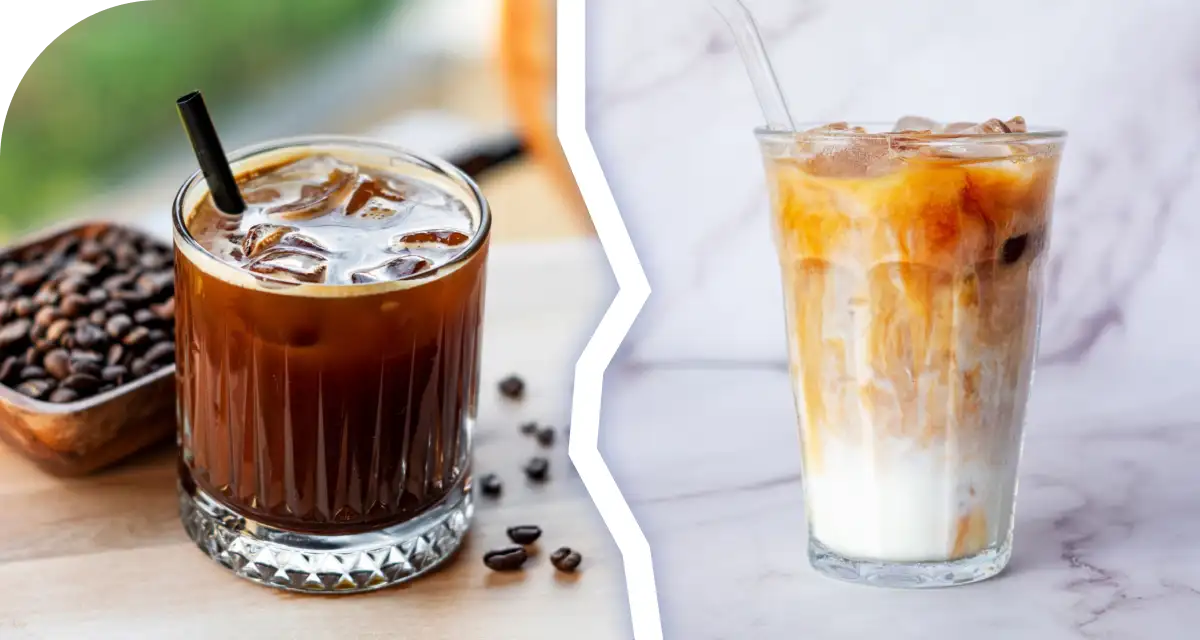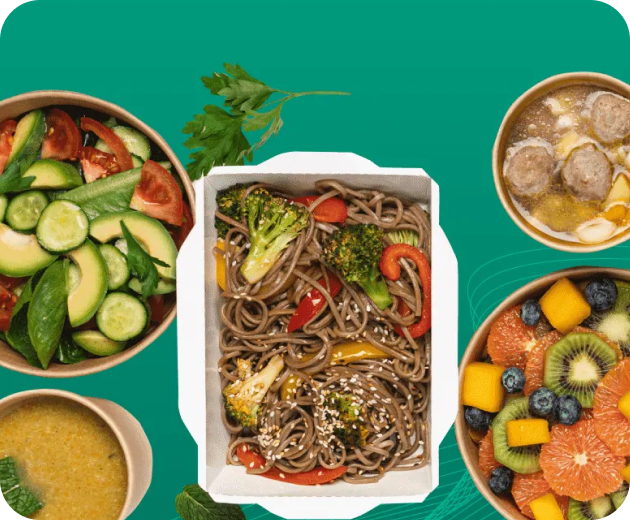Iced Coffee vs Iced Latte: the Ultimate Chilled Showdown
When it comes to chilled coffee drinks, iced coffee vs iced latte is a topic that continues to captivate the food and beverage industry. Both beverages are experiencing a surge in popularity, driven by evolving consumer preferences and an expanding coffee culture.
According to Tastewise, iced coffee has grown by 6.25% in social discussions over the past year, and 16.05% of restaurants now include it on their menus.
Meanwhile, iced latte boasts a higher growth rate of 9.73% in social discussions, though only 2.6% of restaurants offer it on their menus.
These numbers reflect the growing importance of understanding trends and consumer behaviors to capitalize on opportunities in this space.
What is iced coffee?
Iced coffee is a chilled version of brewed coffee, served over ice. It can be made from hot coffee that’s cooled or through the a method where coffee grounds steep in cold water for 12-24 hours. This process enhances the natural sweetness and reduces acidity, creating a smoother flavor.
Customization is key with iced coffee. Consumers can add milk, cream, or syrups to suit their tastes.
Current iced coffee trends show that ready-to-drink (RTD) products and nitro-infused options are becoming consumer favorites.
What is iced latte?

An iced latte is a twist on the classic latte, made with a creamy espresso-base that combines one or two shots of espresso with milk and ice.
It is richer and smoother than iced coffee due to its higher milk content, with a standard milk-to-espresso ratio of 3:1.
Iced lattes are known for their versatility, with endless customization options ranging from plant-based milks like oat or almond to flavored syrups like vanilla and caramel.
These choices make them particularly appealing to health-conscious and trend-savvy consumers. Latte trends highlight the rise of plant-based variations and seasonal flavors like pumpkin spice and peppermint mocha.
Key differences between iced coffee and iced latte
| Feature | Iced Coffee | Iced Latte |
| Main ingredient | Brewed coffee | Espresso |
| Milk content | Optional, usually minimal | Required, higher milk-to-espresso ratio |
| Texture | Light, refreshing | Creamy, indulgent |
| Caffeine content | Higher (due to larger coffee base) | Lower (espresso diluted with milk) |
| Customization | Milk, sweeteners, syrups | Syrups, plant-based milk options |
Taste & texture: how they compare
Understanding the difference between an iced coffee and an iced latte starts with their foundation: the type of coffee used and how milk is incorporated.
Iced coffee is typically brewed using regular brewed coffee or cold brew coffee, then poured over ice. It offers a refreshing, slightly bitter profile with a lighter texture. Whether you use a French press or a drip machine, the result is a cold coffee drink that’s ideal for a hot summer day. A splash of milk or sweetener can be added, but iced coffees often let the flavor of the coffee beans take center stage.
In contrast, an iced latte is made with espresso and milk, typically using a double shot of espresso poured over ice cubes and mixed with cold milk, often in a 3:1 ratio. This gives the iced latte its creamy, smooth texture. The type of milk, whether it’s whole milk, almond milk, or another plant-based option, can significantly influence the final taste and mouthfeel.
So if you’re comparing a latte vs iced coffee, consider the amount of milk and the texture you’re after. Latte and iced coffee are both delicious, but their appeal lies in very different drinking experiences.
Best pairings for iced coffee and iced lattes
The best pairings bring out the richness of coffee while catering to different consumer moods and occasions. Each drink has its own personality, and the food or flavor pairing should reflect that.
Iced coffee, with its robust and bold profile, pairs well with pastries that complement its natural bitterness, think chocolate croissants, nutty biscotti, or even a slice of banana bread. These classic pairings enhance the richness of regular brewed coffee, especially when served in a glass with ice. For health-conscious options, consider pairing it with protein bites or oatmeal cookies made with ground coffee for a functional kick.
Iced lattes, with their creamy base made with espresso and milk, offer more room for sweet or lightly savory matches. Flavors like vanilla or hazelnut pair beautifully with a warm cinnamon roll, a buttery scone, or even avocado toast. The smoothness of a latte made with whole or almond milk complements these flavors, while the espresso base balances sweetness.
Whether you’re crafting iced coffee recipes for a summer campaign or exploring new offerings for your coffee shop, keep in mind the amount of caffeine and type of milk used, it could influence which pairings resonate most with your audience.
The coolest trends in iced coffee and iced lattes
Cold brew dominance
This continues to lead the iced coffee market due to its smooth, less acidic taste. The market is projected to reach $1.37 billion by 2027, fueled by its versatility and growing consumer interest in premium-quality RTD options.
Nitro iced coffee
Nitro coffee, infused with nitrogen gas, offers a creamy texture without added dairy. This visually appealing option is popular among millennials and Gen Z, with brands leveraging its luxurious feel to attract attention in cafes and grocery aisles.
Health-conscious options
The demand for low-calorie, plant-based iced coffee continues to rise. Functional benefits, such as added protein or vitamins, are especially appealing to younger consumers looking to align their beverage choices with a healthier lifestyle.
Plant-based innovation
Sustainability and dietary preferences are driving the adoption of plant-based milks in iced lattes. Oat milk leads the pack due to its creamy consistency and eco-friendly appeal, followed by almond and soy.
Flavored and seasonal lattes
Iced lattes are becoming more adventurous with flavors. Popular choices now include caramel, vanilla, and hazelnut, but unique flavors like ube (a purple yam) and mint are also gaining traction.
These innovations allow consumers to enjoy a more indulgent experience while exploring new taste profiles56. Seasonal flavors, such as salted caramel and gingerbread, are particularly popular during specific times of the year3.
Social media-worthy aesthetics
The visual appeal of iced lattes, featuring artistic layers and vibrant syrups, has skyrocketed thanks to platforms like Instagram and TikTok. This trend elevates the iced latte’s status as a lifestyle drink, encouraging consumer engagement and brand visibility.
Popularity: iced coffee vs iced latte
Globally, iced coffee leads the way in terms of sheer consumption, with variations like frappes dominating in over 35 countries. In the U.S., iced coffee accounts for a significant share of the $96 billion coffee market, fueled by RTD options.
Meanwhile, iced latte
s are carving out a niche among younger, health-conscious audiences. These beverages shine on social media, thanks to their photogenic qualities and customizable nature. Popular flavors and plant-based ingredients contribute to their steady rise in demand.
FAQs about iced coffee vs iced latte
Choosing between iced coffee and iced lattes starts with your audience. Are they drawn to high-energy, no-frills options? Iced coffee might be your go-to. Cold brew coffee—made by steeping ground coffee in cold water—is especially popular among consumers seeking bold flavor with less acidity. It’s a refreshing drink served over ice, ideal for a coffee-forward experience that still allows room for customization.
On the other hand, if your market leans toward indulgence, health-conscious ingredients, or aesthetically driven experiences, iced lattes may offer more value. A latte is made with espresso and milk, providing a creamy base that pairs well with flavor innovations. Tastewise data helps identify which trend resonates most with your demographic, offering guidance not just on what’s popular, but on what’s actionable.
Generally, iced coffee contains fewer calories because it’s often served black or with a minimal splash of milk. Cold brew and regular brewed coffee poured over ice creates a low-calorie drink that can be enhanced without compromising its health appeal.
Iced lattes, while delicious, contain more calories due to the larger amount of milk used. However, using unsweetened almond milk or other low-calorie alternatives can help balance indulgence and wellness. With the right formulation, both coffee options can meet your audience’s nutritional preferences.
If you’re comparing by volume, iced coffee typically has more caffeine. This is because it’s made using a larger quantity of regular brewed coffee or cold brew, which tends to be higher in caffeine per ounce.
That said, iced lattes, made with one or two shots of espresso, can still pack a punch. The total caffeine depends on how many espresso shots you use. If your audience is looking for an energy boost with a smoother mouthfeel, a double espresso iced latte made with less milk could hit the spot.
Yes, by definition, an iced latte is made with espresso and milk served over ice. The espresso provides the bold base, while the milk creates a rich, smooth texture. Some consumers may not realize the difference between iced coffee and iced lattes, but it’s all about the coffee type: brewed vs. espresso.
If you’re developing iced latte recipes, consider varying the type of milk or the number of espresso shots to appeal to different taste preferences. These adjustments can also influence the overall flavor profile and nutritional value.
In the competitive world of coffee, access to real-time insights gives brands the edge they need to make smart, confident decisions. Tastewise’s platform analyzes millions of data points to identify emerging preferences—whether your consumers are leaning toward espresso-based drinks or favoring coffee poured over ice.
From understanding the nuances of milk choice to spotting which coffee-forward trends are gaining momentum, food intelligence helps businesses stay relevant. It’s not just about tracking what people drink, it’s about anticipating their next coffee move and delivering it before they ask.




